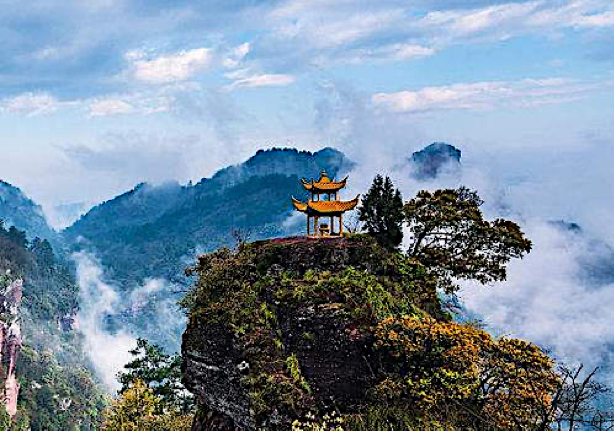A spiritual philosophy which shares some similarities with Buddhism, Taoism is a major religion in the East and has existed in China for more than two thousand years. Taoist temples were established in China as early as the Eastern Han dynasty and there are many mountains dedicated to them. However, there are four in particular which are regarded as particularly sacred: Wudang, Mount Qingcheng, Longhu Mountain and Qiyun Mountain.
1. Wudang Mountain – Hubei

Chosen as a royal mountain by the Ming Dynasty, Wudang Mountain stretches over 312 square km and reaches 1612 metres high. It’s the location where Tai Chi originated, and it continues to act as an important base for the meditative martial art.
There are some stunning sights on the way up this mountain including Fuzhen Temple, the largest and best-preserved Taoist temple and Golden Palace, the highest holy Taoist hall. These are surrounded by many other temples, shrines and monasteries, plus the famous Forbidden City.
2. Mount Qingcheng – Sichuan

Mount Qingcheng is situated in Dujiangyan, within Sichuan and is an incredibly important location for Taoism. Legend says that Mount Qincheng is where Zhang Ling, a famous Chinese philosopher, recorded the guiding principles of Taoism for the first time in 142 BC.
The highest point of Laoxiaoding Peak is 1260m tall, and the whole mountain covers 200 square km. It’s split into two sections, known as Front Mountain and Back Mountain. The front is where you’ll find Taoist temples and pavilions, while if you head to the back you can enjoy the tranquility of undisturbed nature.
Often described as the cradle of Taoism, Mount Quingcheng has a spectacular landscape such as the elevated Yuecheng Lake and manmade beauties including Shangqing Palace and Zushi Temple.
3. Longhu Mountain – Jiangxi

Lying within Yingtan City in the Jiangxi Province, Longhu Mountain is said to have been the inspiration for many poems and fables, thanks to the spectacular views it offers.
Spread over 220 square kilometres and with an elevation of 1300m, Longhu has 24 caves, 99 peaks and a range of Taoist temples on the mountainside. In the past it had 81 monasteries and 10 Taoist palaces too, but many were either set on fire or fell into disrepair and ruins. The Heavenly Master’s Mansion is one of the few which remain standing today.
Every year, many Taoist devotees take a pilgrimage to the mountain to carry out rites and religious observations.
4. Qiyun Mountain – Anhui

Qiyun Mountain is located 15km to the west within Anhui, and is the smallest and lowest mountain of the four. Its highest elevation is 585 metres and it covers a total area of 60 square kilometres.
Despite its more diminutive size, Qiyun Mountain is no less breathtaking with 72 cliffs, 36 peaks and a plethora of tranquil springs, caves and waterfalls which come together to create a magical landscape. With ancient inscriptions, sacred tablets and features such as the Hanging Walkway, it’s well worth the trip to see it.
